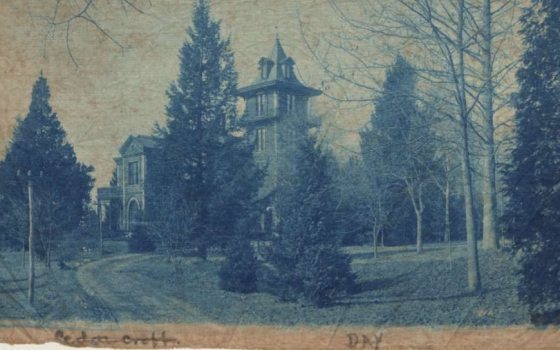There are many stories to be told about the lives of the residents of the Longwood Cemetery, located just outside of the Longwood Gardens entrance, on Greenwood Road. Chartered in 1855, the Longwood Cemetery honors some of the Brandywine Valley’s most revered citizens and their extraordinary influence on the region and beyond. It sits on land once granted by William Penn, located directly in front of the 1854 historic Longwood Meeting House, which then served as the home of the Pennsylvania Yearly Meeting of Progressive Friends. Honoring the history of the cemetery and its place in Brandywine Valley culture, in 2018 Longwood Gardens acquired the Longwood Cemetery property from the volunteer-run cemetery board ... and as Longwood's founder Pierre S. du Pont acquired the Meeting House after it closed in 1940, the two historic properties at long last could be reunited. Longwood wanted to ensure the property was maintained for years to come and tell the stories of these Chester County heroes, including Quaker abolitionists; some of the area’s most famous leaders of the Underground Railroad; Civil War soldiers, doctors, and nurses; and writer and native son Bayard Taylor, who undoubtedly had an influence on du Pont.
The Longwood Gardens Library recently received a generous donation from the Kennett Library of books that belonged to, or were written by, Bayard Taylor. We are honored to be the next caretakers of these books that will help to tell the story of this important local resident for generations to come.

Taylor was born and raised in Kennett Square in 1825 to Quaker parents. An early reader who loved books and poetry, Taylor published his first work in 1840, a description in the West Chester Register of his visit to the Brandywine Battlefield. He published his first book, a volume of poetry titled Ximena, in 1844 at the age of 19.
He journeyed through Europe for two years in 1844 with a cousin and a friend, and the letters that he sent back for publication in several newspapers were compiled into an extremely popular book in 1846. Views A-foot, or Europe Seen with a Knapsack and Staff put him on the path to becoming America’s first great travel writer.

Taylor continued to travel around the world and write about his adventures, becoming a popular speaker and something of a celebrity romantic adventurer. In his travels, Taylor met many other famous writers of the day including Washington Irving, Alfred Lord Tennyson, Henry David Thoreau, Hans Christian Anderson, Elizabeth Barrett Browning, and Mark Twain. Taylor’s rich life also included turns as a diplomat in both Russia and Germany, work as a journalist, and as a lecturer at Cornell University.
Bayard Taylor was married twice, first to his Kennett childhood sweetheart Mary Agnew, who died of tuberculosis. He then wed Marie Hansen in 1857, whom he met on his travels in Germany, and brought her home to Kennett Square. They built their stately home Cedarcroft, which still stands near Routes 82 & 1 in Kennett. It was dedicated with a large celebration performance of Love at a Hotel, written by Bayard Taylor and a friend. Writer Ralph Waldo Emerson was one of the famous attendees at the dedication.

Taylor always considered Kennett Square his home, and in an 1864 letter to a friend described his warm feelings for the area: “These Kennett landscapes, overlaid with pale violet haze, through which glimmer the masses of blossoming trees, have an ideal loveliness….there is not a wood, or field or swamp, or garden, which does not exhale delicious smells.”
In addition to his popular travel writing, Taylor also wrote several novels. The Story of Kennett, first published in 1866, was his “attempt to represent the elements of life in a simple, healthy, pastoral community.” Based upon local events and places, Taylor states in the prologue that he is “…aware that truth and fiction are so carefully woven together in this Story of Kennett, that you will sometimes be at a loss to disentangle them. The lovely pastoral landscapes which I know by heart, have been copied, field for field and tree for tree, and these you will immediately recognize.”

Longwood’s founder clearly had an interest in Bayard Taylor, although the author died in 1878 when du Pont was just 8 years old. Pierre du Pont had at least 21 books written by Taylor in his personal collection. Pierre du Pont’s personal papers, located at the Hagley Museum and Library, include a photographic portrait of Bayard Taylor and a cyanotype printed on cloth of Cedarcroft, as shown in the first photo of this blog post (From the papers of Pierre S. du Pont. Cyanotype printed on cloth. Image courtesy of Hagley Museum and Library).

Bayard Taylor died in Germany in 1878. His fame was so great that his obituary was printed on the front page of The New York Times. Taylor’s gravestone in the Longwood Cemetery contains the Biblical quotation “He being dead yet speaketh” —a fitting verse for an author whose written words live on.


